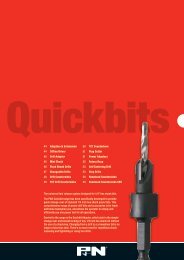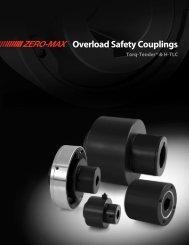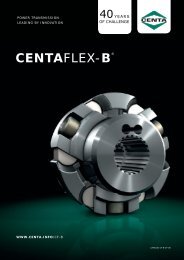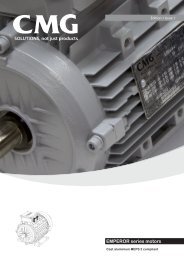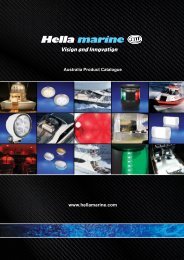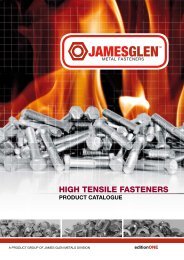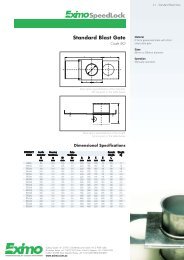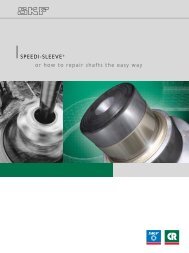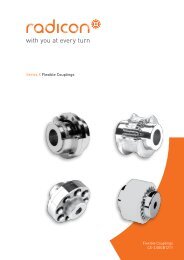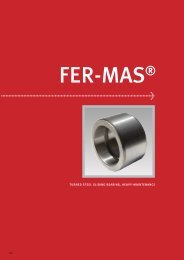Download - Industrial and Bearing Supplies
Download - Industrial and Bearing Supplies
Download - Industrial and Bearing Supplies
Create successful ePaper yourself
Turn your PDF publications into a flip-book with our unique Google optimized e-Paper software.
134 Ignitors <strong>and</strong> Ballasts<br />
TECHNICAL<br />
HID Ignitors <strong>and</strong> Ballasts<br />
The starting voltage for most High-Intensity<br />
Discharge (HID) lamps, especially metal halide<br />
<strong>and</strong> high-pressure sodium types, is higher<br />
than the mains voltage.<br />
Ignitors provide the necessary high voltage to<br />
start such lamps.<br />
The high-voltage pulse varies from 1 to 5kV<br />
depending upon the type of the lamp <strong>and</strong> is<br />
inhibited when the lamp starts.<br />
Hella ignitors are manufactured in<br />
accordance with IEC 60926 <strong>and</strong> IEC 60927,<br />
the International St<strong>and</strong>ards specifying<br />
performance, general <strong>and</strong> safety requirements<br />
for starting devices.<br />
Old high-pressure sodium <strong>and</strong> metal<br />
halide lamps with conventional ignitor<br />
technology often cause visual discomfort <strong>and</strong><br />
electromagnetic interference at the end of the<br />
lamp life when the ignitor would repeatedly<br />
strike the lamp, <strong>and</strong> it would not stabilize<br />
electrically.<br />
This cycling can be a significant irritant <strong>and</strong><br />
become a safety risk.<br />
The solution: ‘PulseControl’ from Hella, the<br />
first digital ignitor in the world.<br />
Greater reliability, greater ignition power,<br />
reduced re-strike time <strong>and</strong> minimum<br />
interference through digital, precise<br />
management of all lamp types without<br />
annoying flashing.<br />
L<br />
N<br />
C<br />
Ballast<br />
HV<br />
BLa N<br />
IGN<br />
Precise lamp management<br />
through digital technology<br />
The patented switching circuit digitally<br />
controls the ignition <strong>and</strong> automatic tripping<br />
logic functions. PulseControl does not<br />
consider the time of the re-strike period but<br />
the number of attempts made. Because of<br />
this, all lamps are switched off after 3 cycles<br />
regardless of luminaire or lamp type.<br />
Re-strike time reduced by<br />
up to 50%<br />
Depending on the lamp wattage, 4–10 ignition<br />
pulses per half wave will be generated.<br />
As a result of the increased ignition power<br />
<strong>and</strong> the pulse/break cycle, the re-strike time is<br />
reduced by up to 50%.<br />
Interference reduced by<br />
up to 90%<br />
This 90% reduction in interference time (only<br />
about 30 sec instead of 300 sec), is due to the<br />
reduced re-strike period <strong>and</strong> the pulse/break<br />
cycle which strikes for 5 seconds then pauses<br />
for 25 seconds.<br />
Ignitor Temperature Rise<br />
Because ignitors have heat-sensitive<br />
elements, their suitability for particular<br />
applications is determined by the rise in the<br />
element’s temperature. When mounting an<br />
ignitor in the luminaire on a control equipment<br />
enclosure, the ambient temperature range of<br />
the application must be considered.<br />
Quality components in Hella ignitors ensure<br />
that they can withst<strong>and</strong> temperatures from<br />
–30°C to +100°C with a minimum power loss.<br />
Long life<br />
Lighting control electronic equipment is<br />
designed to run continuously for a minimum of<br />
80,000 hours when operating at its maximum<br />
temperature. This high level of reliability<br />
can be achieved only by using high-quality<br />
insulation <strong>and</strong> heat-resistant components.<br />
Very low temperature rise in Hella ignitors<br />
makes them highly reliable components for<br />
use in all lighting control equipment.



